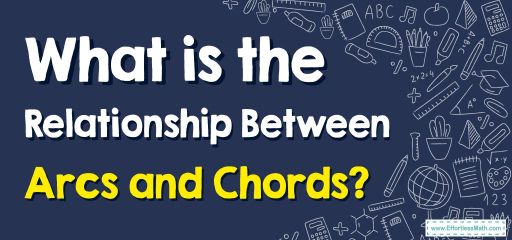What is the Relationship Between Arcs and Chords?
Within the graceful confines of a circle, arcs and chords dance in tandem, establishing relationships and patterns that have intrigued mathematicians for centuries. While arcs define sections of a circle's boundary, chords are the linear segments that connect two points on that boundary. Their interplay defines various principles of circle geometry. This blog post provides a comprehensive exploration of the nuances of arcs and chords and their intricate interrelation.

Step-by-step Guide: Arcs and Chords
Definitions:
- Arc: An arc is a continuous segment of a circle’s circumference.
- Chord: A chord is a straight line segment whose endpoints lie on the circle. Note: The diameter is the longest chord of a circle.
Properties of Chords and Arcs:
- Chords that are equidistant from the center of a circle are equal in length.
- Equal chords of a circle subtend equal angles at the center.
- The perpendicular bisector of a chord passes through the circle’s center.
Relationship between Chords and Arcs:
- Equal chords intercept equal arcs.
- The angle subtended by an arc at the center is double the angle subtended by it at any point on the remaining part of the circle.
Calculating Length of Chords:
If we know the arc and radius, the chord’s length, \(c\), can be approximated using:
\(
c \approx 2r \sin\left(\frac{\text{arc angle in radians}}{2}\right)
\)
Examples
Example 1:
Two chords, \(AB\) and \(CD\), of a circle are of equal length. If the arc intercepted by chord \(AB\) measures \(80^\circ\), what is the measure of the arc intercepted by chord \(CD\)?
Solution: Given that equal chords intercept equal arcs, the arc intercepted by chord \(CD\) will also measure \(80^\circ\).
Example 2:
In a circle, an arc intercepts an angle of \(40^\circ\) at the boundary. What is the angle subtended by this arc at the center?
Solution: The angle subtended by an arc at the center is double the angle subtended on the boundary. Therefore, the central angle is \(2 \times 40^\circ = 80^\circ\).
Example 1:
Find the length of a chord that intercepts an arc of \(60^\circ\) in a circle with a radius of \(10 \text{ cm}\).
Solution: Convert the angle to radians: \(60^\circ \times \frac{\pi}{180} = \frac{\pi}{3} \text{ radians}\). Using the formula:
\(
c \approx 2 \times 10 \times \sin\left(\frac{\pi}{6}\right) \approx 10 \sqrt{3} \text{ cm}
\)
Practice Questions:
- In a circle with a radius of \(7 \text{ cm}\), what is the approximate length of a chord that intercepts an arc of \(90^\circ\)?
- If an arc subtends an angle of \(30^\circ\) at the boundary of a circle, what angle does it subtend at the center?

Answers:
- \( c \approx 2 \times 7 \times \sin(45^\circ) \approx 9.9 \text{ cm}\)
- \( 2 \times 30^\circ = 60^\circ \)
Related to This Article
More math articles
- How long Is the ACCUPLACER Test?
- How to Solve a Quadratic Equation by Completing the Square?
- Take GED Test Online for Free
- The Ultimate OAR Math Course (+FREE Worksheets)
- 10 Most Common 8th Grade Common Core Math Questions
- 8th Grade LEAP Math Worksheets: FREE & Printable
- Best Calculators for High School Algebra II
- How to Solve Linear Equation and Inequality Word Problems?
- How to Handle Your Math Assignments?
- FREE 6th Grade OST Math Practice Test


























What people say about "What is the Relationship Between Arcs and Chords? - Effortless Math: We Help Students Learn to LOVE Mathematics"?
No one replied yet.